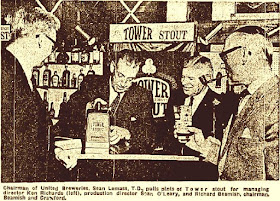Following on from my last post about Tower Stout it seems appropriate to continue with another lost Beamish & Crawford beer, this time an ale launched to mark the 50th anniversary of the 1916 Easter Rising. Touted as a 'strong ale'1, Celebration arrived smack bang into the hard fought beer drinking world at a time of severe upheaval in the Irish ale scene, and into that short period in the 1960s and early 1970s when their sales were in the ascendancy.
Image Source - Author's own collection
On the 4th of April 1966 the Monday edition of The Irish Press carried a short column sandwiched between escalating problems in Vietnam and an obituary for the car designer Battista Farina stating that a new ale called simply 'Celebration' would be for sale on draught from that date in fifty Dublin pubs. The official launch had been the previous month in Cork city and county2 after it had been blind tested for several months, so presumably it was decided that a new ale was firstly needed, or needed by Beamish & Crawford anyway, and it must have been relatively well received by Cork's finest ale drinkers.
By July of 1966 it had received 'outstanding popularity in Waterford and throughout Ireland' and it was available in half-pint bottles, pint bottles as well as on draught, and it claimed that it was 'the only ale sold here [in Ireland] in pint bottles'.1 (There's a picture of the stubby pint bottles here.) I wonder was this the start of the South-East's love affair with the large bottle of ale?
By December of 1966 it was mooted that Celebration would be launched in the UK - somewhat ironically given what it was launched to celebrate - in some of Charringtons United Breweries 6,205 tied houses in which Beamish & Crawford's owners Canadian Breweries had a 10% stake. At this time it already had 15% of the ale market in Ireland and the company were also making inroads into the lager sector with Carling Black Label.3
Although imported before then, towards the end of 1968 Bass began to be brewed in Beamish & Crawford and this was followed by Worthington's in late 1969, adding to a severely crowded draught ale marketplace of Smithwicks, Watneys Red Barrel, Phoenix, Macardles, Double Diamond and a number of smaller ale brands. Bass sales soon outstripped Celebration and in April 1970 its above mentioned Dublin taps were withdrawn along with those in northern half of the country, the half pint bottles were dropped and it seems to have quietly ceased to exist entirely in 19712 as the company put its faith in Bass for the battle of the ale market share.
As to its taste, appearance and alcohol content I can only guess at two, but it was certainly a pale ale like Phoenix more so than a darker one like most of its other rivals. In 1966 it won a gold medal in Brussels but this doesn't tell us much, and two of the beermats in my possession use words such as 'Big Beer', 'Full Bodied' and 'Powerful' which perhaps hint at its taste and marketing strategy - more telling perhaps as to its strength might be this quote from a Cork forum:
Although imported before then, towards the end of 1968 Bass began to be brewed in Beamish & Crawford and this was followed by Worthington's in late 1969, adding to a severely crowded draught ale marketplace of Smithwicks, Watneys Red Barrel, Phoenix, Macardles, Double Diamond and a number of smaller ale brands. Bass sales soon outstripped Celebration and in April 1970 its above mentioned Dublin taps were withdrawn along with those in northern half of the country, the half pint bottles were dropped and it seems to have quietly ceased to exist entirely in 19712 as the company put its faith in Bass for the battle of the ale market share.
As to its taste, appearance and alcohol content I can only guess at two, but it was certainly a pale ale like Phoenix more so than a darker one like most of its other rivals. In 1966 it won a gold medal in Brussels but this doesn't tell us much, and two of the beermats in my possession use words such as 'Big Beer', 'Full Bodied' and 'Powerful' which perhaps hint at its taste and marketing strategy - more telling perhaps as to its strength might be this quote from a Cork forum:
"It was by far the strongest drink to hit the bars at that time.I still hear stories from ould fellas chatting about the state and condition that fellas would get in,from drinking 'a few pints'"
Make of that what you like...
Image Source - Author's own collection
My collection of Celebration breweriana is quite scarce but I do possess a nice set of beer mats and a pint bottle label, sadly I don't have one of the nice Waterford glasses that you can see in the advertisement above and on one of these beer mats - yet...
Image Source - Author's own collection
Liam
(All written content and the research involved in publishing it here is my own unless otherwise stated and can not be reproduced elsewhere without full credit to its source and a link back to this post.)
References:
1 Munster Express - 8th July 1966
2 Beamish & Crawford: The History of and Irish Brewery, Donal Ó Drisceoil & Diarmuid Ó Drisceoil (2015)
3 The Cork Examiner - 15th December 1966
Advert via local library local studies room



























